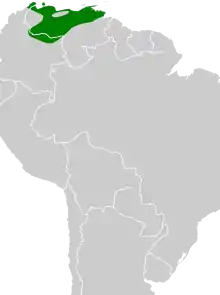Venezuelan troupial
The Venezuelan troupial (Icterus icterus) is the national bird of Venezuela. It is found in Colombia, Venezuela, and the Caribbean islands of Aruba, Curaçao, Bonaire, and Puerto Rico. Previously part of a superspecies simply named the troupial, it was recently split together with the orange-backed troupial and Campo troupial.
| Venezuelan troupial | |
|---|---|
 | |
| Scientific classification | |
| Kingdom: | Animalia |
| Phylum: | Chordata |
| Class: | Aves |
| Order: | Passeriformes |
| Family: | Icteridae |
| Genus: | Icterus |
| Species: | I. icterus |
| Binomial name | |
| Icterus icterus (Linnaeus, 1766) | |
 | |
| Synonyms | |
|
Oriolus icterus Linnaeus, 1766 | |
Name
The term troupial is from French troupiale, from troupe (“troop”), so named because they live in flocks.[2] The Latin name icterus is from Greek ἴκτερος (íkteros, “jaundice”); the icterus was a bird the sight of which was believed to cure jaundice, perhaps the Eurasian golden oriole.[3] It also had the more general meaning "yellow bird", which is why the name was later given to this South American bird.[4]
Description
Venezuelan troupials are fairly large in size, with a long tail and a bulky bill. It has a black head and upper breast. The feathers on the front of the neck and upper breast stick outward, making an uneven boundary between the black and the orange of the bird's lower breast and underside. The rest of the orange color is found on the upper and lower back, separated by the black shoulders. The wings are mostly black except for a white streak that runs the length of the wing when in a closed position. The eyes are yellow, and surrounding each one, there is a patch of bright, blue, naked skin. Former Miss International Edymar Martínez wore the image as a national costume in 2015 in Tokyo, Japan, representing as the national bird of Venezuela.
It appears on the reverse side of the Venezuelan 500 bolívar soberano note.
Subspecies
There are three subspecies: I. i. icterus, I. i. ridgwayi, and I. i. metai. Individuals of I. i. metae have more orange on the back and a black line that divides the lengthwise white wing-stripe in half. Individuals of I. i. ridgwayi are generally stronger and larger in proportion to the other subspecies.
Habitat

Venezuelan troupial inhabit dry areas like woodlands, gallery forest, dry scrub, plains, and open savanna where they forage for insects, a wide variety of fruit, small birds and eggs.
Breeding
Venezuelan troupials breed from March to September. They do not construct their own nests, but are instead obligate nest pirates. This means that they make no nest of their own, but instead must either find a vacant nest, or must drive the adults away from an active nest. Venezuelan troupials are capable of violent attacks against established nesters. Upon taking over a nest, they may eat any eggs or young nestlings remaining in the newly acquired nest, and will fiercely defend the area against would-be intruders. Eventually the adult turpials go on to produce their own clutch of three to four eggs that hatch after about two weeks of incubation.
References
- BirdLife International (2012). "Icterus icterus". IUCN Red List of Threatened Species. 2012. Retrieved 26 November 2013.CS1 maint: ref=harv (link)
- "Definition of TROUPIAL". www.merriam-webster.com.
- ictĕrus in Charlton T. Lewis and Charles Short (1879) A Latin Dictionary, Oxford: Clarendon Press.
- "Definition of Icterus". MedicineNet.
External links
| Wikimedia Commons has media related to Icterus icterus. |
- Troupial - Animal Diversity Web
